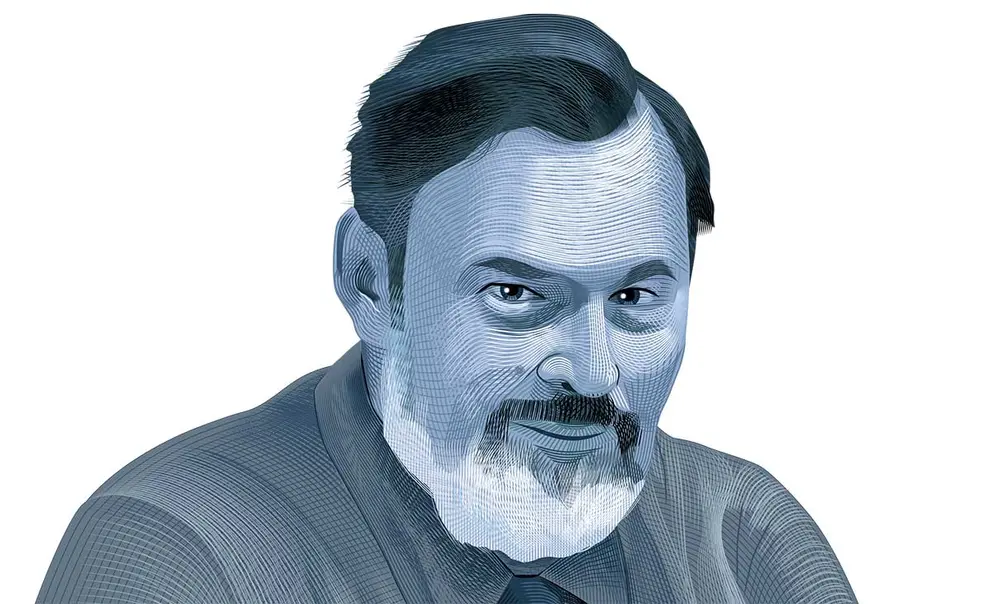David Lewin *58 Drew Otherworldly Music From A Computer
Princeton was a pioneering institution for computer-created music
The composer lifts his arms, pausing while writing a line of music to sketch, with his body, the flow of melody from the instrument. He closes his eyes and moves his hands, imagining his fingers hovering over the keys ... of a Bell Labs mainframe computer.
David Lewin *58 was the first professional composer to use computer technology to write and produce music. In 1961, a Bell Labs engineer named Max Mathews, who had developed hardware and software that could convert digital signals to analog and thus play digital instructions as music, wanted to see how an “adventurous musician” might use the technology. He reached out to Lewin, who had turned down a mathematics fellowship at Princeton to study music there instead, and who, as a postdoctoral fellow at Harvard, was making waves as an exceedingly mathematical musician.
Meticulous and playful, Lewin liked to transform the phone numbers of friends into fugues. He later advised a colleague who was teaching a course on counterpoint to a class of 45 students to turn the assignments into a combinatorial game: “Teach three-part inventions, have 15 each write a top voice, 15 a middle voice, and 15 a bass voice. There will be 3,375 possible inventions, and a measure or so of one of ’em is bound to work after a fashion. The students can be assigned to check for the best measure.”
Mathews taught Lewin the programming language Fortran II; this language, which humans could read, then had to be translated into machine language on punch cards, with hundreds of cards required to produce just one second of sound. “Since I was living in Cambridge, Massachusetts,” Lewin later said, “I would write programs and mail them to New Jersey, where staff would put them on [punch] cards and run them, sending me analog-converted results by return mail.”
Some of Lewin’s experiments appear on a remarkable record that Bell Labs released in 1961, titled Music from Mathematics. The sounds on the LP are otherworldly, the first audio reports from a new planet — a dialogue between synthesizers, sorrowful minor-key melodies, and the found noises of electronics, soon to be the soundtrack of modern fantasy: the whirling ooop that follows a UFO in a B-movie, the looping staircase melodies of video games.
Princeton University, which was just 40 miles from Bell Labs headquarters in Murray Hill, New Jersey, was a pioneering institution for computer-created music. J.K. Randall *58, a professor at Princeton, and Charles Dodge, who taught music at Columbia, were — along with Lewin — among the first composers to write music for computers. Godfrey Winham ’56 *58 *65, a lecturer in Princeton’s music department, taught the first-ever course on the subject in 1966. The Princeton composers, as musicians call a group of Princetonians who applied mathematical set theory to music theory, laid the basis for the singing of circuits: Music is numbers, and so are computers. Lewin went on to teach music at Stony Brook University and Yale, among other institutions.
The Bell Labs record includes a piece designed to check the accuracy of the computer’s output: a synthetic voice singing “Daisy Bell (Bicycle Built for Two).” The director Stanley Kubrick borrowed the conceit for his 1968 film 2001: A Space Odyssey, in which HAL 9000, the supercomputer in the film, sings the same song. Following Lewin’s triumphant debut with Mathews, researchers at Bell Labs and Princeton collaborated widely on programs for producing synthetic sound.












2 Responses
Richard Cohn
9 Months AgoLewin’s Lasting Influence
David also went on to become one of the most influential music theorists of the late 20th century. His status among theorists is legendary. He was a one-of-a-kind character, a deeply ethical colleague, much beloved and still missed 20 years after his passing.
Thanks for the article.
Jon Harper *68
5 Years AgoAnother Computer Music Pioneer
The article about David Benjamin Lewin *58 (Princeton Portrait, June/July issue) was interesting. I thought readers might be interested in another computer-music pioneer, Lejaren Hiller ’45 *47. Hiller earned a Ph.D. in chemistry from Princeton and worked for DuPont before moving to the academic world and working on computerized compositions. One example of his work can be found on YouTube at bit.ly/LejarenHiller.